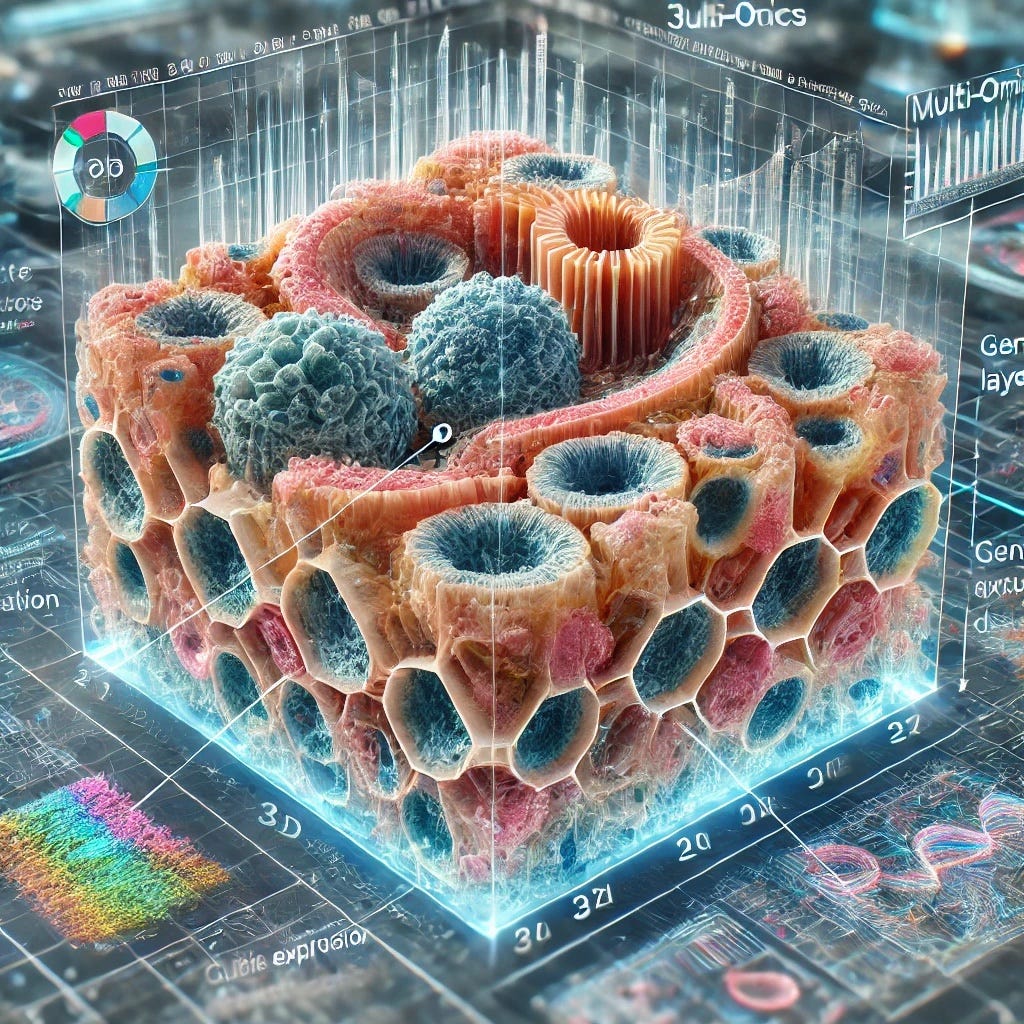Unveiling the 3D Organization of Tissues Through Spatial Multi-Omics
A wonderful example of all of Nexco’s specialties at the core of bioinformatics for -omics analyses

A recent study published in NPG’s Communications Biology has illuminated the spatial organization of muscle fibers within murine tibialis anterior muscles in three dimensions, by integrating spatially resolved multi-omics. The structural organization unveiled in the study is certainly quite intricate, but makes full functional sense: it turns out that the proportions of different myofiber subtypes, as dictated by their gene expression patterns and also evident in metabolic profiles, differ along the length of the muscle, optimizing the arrangement of the metabolic pathways that produce ATP.
At the heart of the study lies an integration of various spatial -omics approaches, more specifically RNA tomography and mass spectrometry imaging, that allowed the 3D visualization of transcriptomic, metabolomic, and lipidomic profiles across the studied tissue. And of course, quite a bit of bioinformatics as we develop below.
The study found that a strong regionalization of gene expression and metabolic activities along the muscle’s proximal-distal axis results in the varying proportions of myofiber types, each with distinct metabolic profiles. The high resolution coming from the transcriptomics data identified differential expression for 405 genes enriched in central muscle sections and 281 in proximal-distal sections, with consistent patterns across different muscles. The gene ontologies suggest a specialized compartmentalization of glycolytic and oxidative fibers. Validation through RNA fluorescence in situ hybridization and multiplex immunofluorescence staining confirmed the spatial distribution of fiber types and metabolic pathways. The study’s outcome is not only of fundamental nature, but it also identified various markers that could in the future be used for diagnosis or as targets of muscle disorder-related diseases.
Bioinformatics-intensive research, Nexco’s specialty
The research presented in this paper requires a mastery of various bioinformatics procedures in order to process and put together the information coming from the various advanced molecular techniques. That is Nexco’s core specialty at its best, after over a decade assisting cell biology labs in the academic and private sectors.
Similar kinds of skills and experience can help scientists to more broadly explore tissue heterogeneity and unveil the spatial distribution of cellular and tissue functions. In fact, similar spatial -omics can be applied to other tissues to understand the organization and interplay of different cell types within a complex environment. Integrating multi-omics data in turn provides a holistic view of biological processes, which is crucial for developing targeted therapies and understanding disease mechanisms:
- What is Spatial Transcriptomics?
- Integrating Single-Cell and Spatial Transcriptomics: An Exciting New Era
The use of bioinformatics is essential for processing, analyzing and interpreting these typically large datasets, and to eventually identify patterns that can lead to new biological insights. Let’s delve a bit deeper into the exact use of bioinformatics, programming, and software to explore the spatial compartmentalization and 3D organization of tissues, through the specific example coming from this study:
Spatial Transcriptomics and Metabolomics: The use of RNA tomography and mass spectrometry imaging enabled in this work the mapping of spatial transcriptomic, metabolomic, and lipidomic organization. These techniques are crucial because they maintain the spatial context that is often lost with traditional tissue dissociation methods, and certainly require quite a bit of familiarity with the kinds of data and with proper processing and analytical procedures.
Data Analysis, especially dimensionality reduction and clustering: Bioinformatics tools like Principal Component Analysis (PCA) and unsupervised Leiden clustering analysis were employed in this work to handle the complex datasets generated by the multi-omics approach. These tools facilitated the identification of distinct patterns of gene expression and metabolic activity, which are essential for understanding muscle biology. There are various techniques for dimensionality reduction, such as PCA, clustering with various protocols, t-SNE maps, UMAP plots, etc. Each of them has its advantages and disadvantages, and it often happens that some are more adequate for a given dataset, technique, and/or question (a detailed comparative analysis here).
Other important clustering methods utilized widely in bioinformatics (and in this work too) is non-supervised clustering analysis, which allows to identify patterns in the data without any prior knowledge, thus reducing biases and allowing researchers to reach conclusions even in total lack of any annotation, cell state assignment, or GO analysis.
Differential Gene Expression Analysis: This tool drawn from bioinformatics was used in this work to identify genes that are expressed differently in various sections of the muscle, providing insights into the regionalization of fiber type and metabolism-related genes. Proper data processing, controlling for batch effects, and mastery of the underlying statistical procedures is here central.
Gene Ontology (“GO”) Enrichment Analysis: Given a set of genes that are up- or down-regulated under certain conditions, an enrichment analysis will find which annotations are under- or over-represented. Knowing the available databases and enrichment calculation tools is essential here, to ensure that the analysis achieves its goal of understanding the biological processes underpinning the differentially expressed genes.
Cell Type Quantification: By using so-called atlases that define the known -omic states of different cells, this important area of bioinformatics allows to classify cells according to their states, and then quantify them. Knowing the specialized software and the curated atlases is here essential to achieve reliable cell state assignment and quantification.
References and more reads
Related Posts

Nos locaux:
Nexco Analytics Bâtiment Alanine Route de la Corniche 5B 1066 Epalinges, Switzerland
Appelez-nous
+41 76 509 73 73
Laissez-nous un message
contact@nexco.chN'hésitez pas à nous laisser un message
Nous nous ferons un plaisir de vous répondre et de trouver des solutions optimales à vos besoins.
